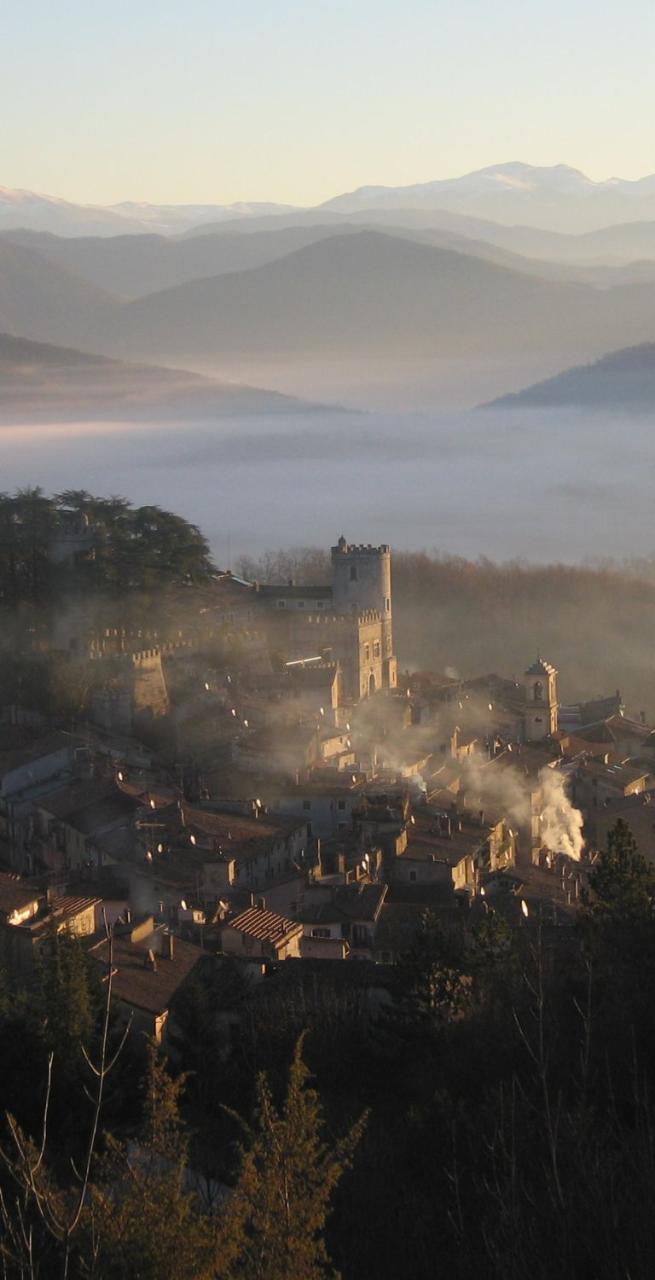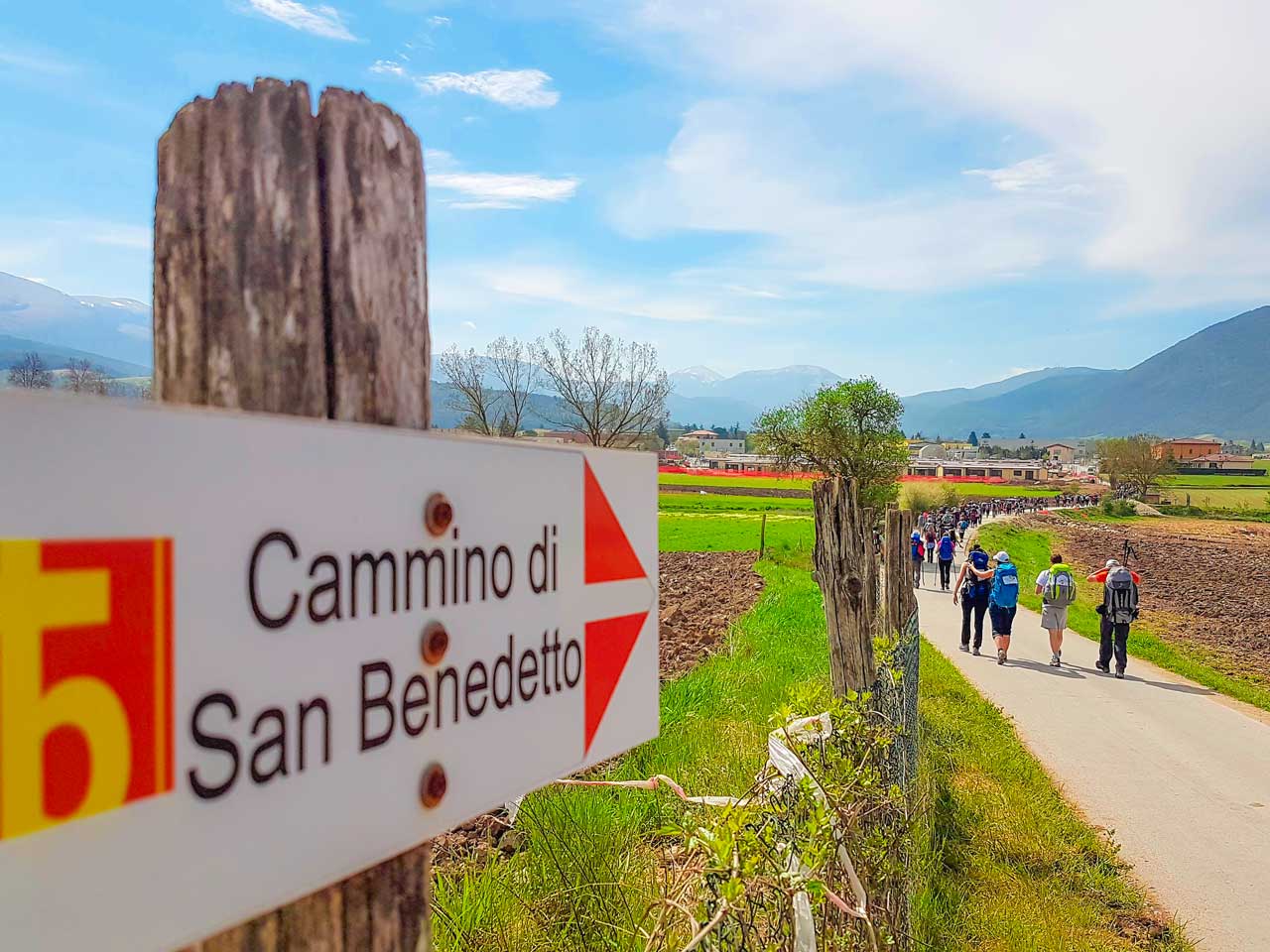



The Cammino di San Benedetto is inspired by the life of St. Benedict, a figure who shaped not only Italian spirituality but also the very roots of European culture. Known as the “Father of Western Monasticism,” Benedict dedicated his life to balance, discipline, and community — values that still resonate today.
Yet beyond his role as a saint, Benedict was a man of the mountains and valleys of central Italy, deeply tied to the landscapes where he lived, prayed, and founded communities. To walk the Cammino di San Benedetto is to follow in his footsteps across Umbria and Lazio, from his birthplace in Norcia to the great Abbey of Montecassino.
Just like the Way of St. Francis, walking here does not require religious motives. Many choose the route for the beauty of its forests, the quiet strength of its monasteries, the authenticity of its villages, and the chance to slow down and find a steadier rhythm of life.
DISCOVER THE CAMMINO DI SAN BENEDETTO
Origins. Benedict was born in Norcia around 480 AD into a noble Roman family. Sent to study in Rome, he quickly grew disillusioned with the city’s corruption and chaos, retreating into the wilderness to seek solitude and meaning.
Solitude at Subiaco. For several years, he lived as a hermit in a cave near Subiaco, dedicating himself to prayer and reflection. This period forged the foundation of his spiritual path: silence, discipline, and the search for harmony.
The Rule of St. Benedict. His reputation as a wise guide drew followers, and eventually he founded monastic communities. His Rule emphasized moderation, humility, work, prayer, and stability — principles that would shape monastic life across Europe for centuries.
Montecassino. Around 529 AD, Benedict established the Abbey of Montecassino, south of Rome, which became the symbolic and spiritual center of his movement. From there, the Benedictine tradition spread widely, influencing culture, art, education, and agriculture throughout Europe.
To walk in his spirit. The route is not just about reaching Montecassino; it is about living something central to Benedict’s life: balance between body, mind, and spirit. Each step reflects his motto, Ora et Labora — pray and work — but also the idea of walking as a daily practice of presence.
A transformative experience. The Cammino takes you through remote villages, quiet forests, medieval abbeys, and rugged hillsides. The rhythm of walking reveals details often missed: the fragrance of pine and chestnut woods, the silence of hermitages, the bells of a monastery echoing through the valley. It is a journey of contemplation and discovery, whether spiritual or simply human.
A living tradition. Unlike the grand, pan-European Francigena, the Cammino di San Benedetto traces the very movements of one man. Following it today is to re-live a legacy that shaped Europe — while at the same time creating your own journey of meaning.
Tra-Norcia-e-Cascia.jpg)
There was no official “Cammino di San Benedetto” in Benedict’s time. But the places we walk today are the ones where he truly lived, prayed, and founded his communities.
· Norcia: his birthplace, where his story began.
· Subiaco: where he spent years in retreat, living in a cave above the Aniene Valley.
· Montecassino: the abbey he founded, still standing as a beacon of culture and spirituality despite centuries of destruction and rebuilding.
Between these points, the Cammino threads together towns, monasteries, sanctuaries, and villages that mark the Benedictine tradition, transforming his historical movements into a coherent modern journey.
· Norcia: Surrounded by the Sibillini Mountains, Norcia still preserves traces of Benedict’s birth and legacy. It is also renowned for its gastronomy and mountain culture.
· Subiaco: The Sacro Speco (Holy Cave) is a stunning sanctuary clinging to the cliff, decorated with centuries of frescoes. It was here Benedict shaped his vision of community life.
· Montecassino: The great abbey, destroyed and rebuilt several times, remains a powerful symbol of resilience and continuity. From here the Benedictine order spread across Europe.
· Other highlights along the way: Medieval towns like Cascia, Leonessa, and Arpino, monasteries like Trisulti, and hidden valleys dotted with hermitages, all weave together the fabric of the route.
-Scendendo-a-Poggio-Bustone.jpg)
While Francis is often remembered as the “patron of ecology,” Benedict represents something equally relevant: balance. His Rule was about harmony — between solitude and community, prayer and work, stability and movement. Walking his path invites us to explore the same: how to balance
the noise of modern life with silence, the rush of schedules with the steady pace of walking, the individual journey with encounters along the way.
Routes, Stages & Distances The Cammino stretches about 300 km from Norcia to Montecassino, usually divided into 16 stages. Each stage covers 15–25 km, though some are longer.
Daily Rhythm, Stage Difficulty & Terrain The route is considered of medium difficulty. Expect rolling hills, forested paths, ancient mule tracks, and occasional steep climbs. Some days are demanding, but none require technical mountaineering experience.

· Spring (April–June): wildflowers, lush landscapes, pleasant walking temperatures.
· Autumn (September–October): warm colors, harvest season, crisp air.
· Summer: can be hot, especially in exposed areas. Early starts are recommended.
· Winter: quieter, but high sections may see snow or limited services.
Accommodation & Services Along the way you’ll find small hotels, B&Bs, agriturismi, and sometimes monastic guesthouses. With a tour operator, you can enjoy the comfort of private rooms with bathrooms, luggage transfers, and pre-arranged bookings that make the journey easier and more enjoyable.
Credential & Testimonium Walkers can obtain the Credenziale del Pellegrino, stamping it along the way. At the end, in Montecassino, you can receive a Testimonium, certifying the completion of the pilgrimage.
Food & Culture Walking the Cammino is also a journey through local flavors: cured meats and cheeses from Norcia, mountain lentils and legumes, rustic breads, truffles, handmade pasta, and wines from Lazio. Every stage is an opportunity to savor traditions passed down for centuries.
Who It’s For The Cammino di San Benedetto is perfect for walkers who want a path less crowded than the Francigena or Santiago, but equally rich in meaning and beauty. It combines challenge and serenity, offering an authentic experience of Italy’s hidden heart.
The Cammino di San Benedetto is more than a walking route: it is a journey into balance, history, and the landscapes of central Italy. From Norcia to Montecassino, it invites you to follow the path of a man whose legacy shaped Europe, but also to find your own rhythm along forests, valleys, and stone villages.
Whether you walk a short section or the entire 300 km, you’ll discover what slow travel truly means: time to breathe, places that speak, and an experience that lingers long after your return.
`